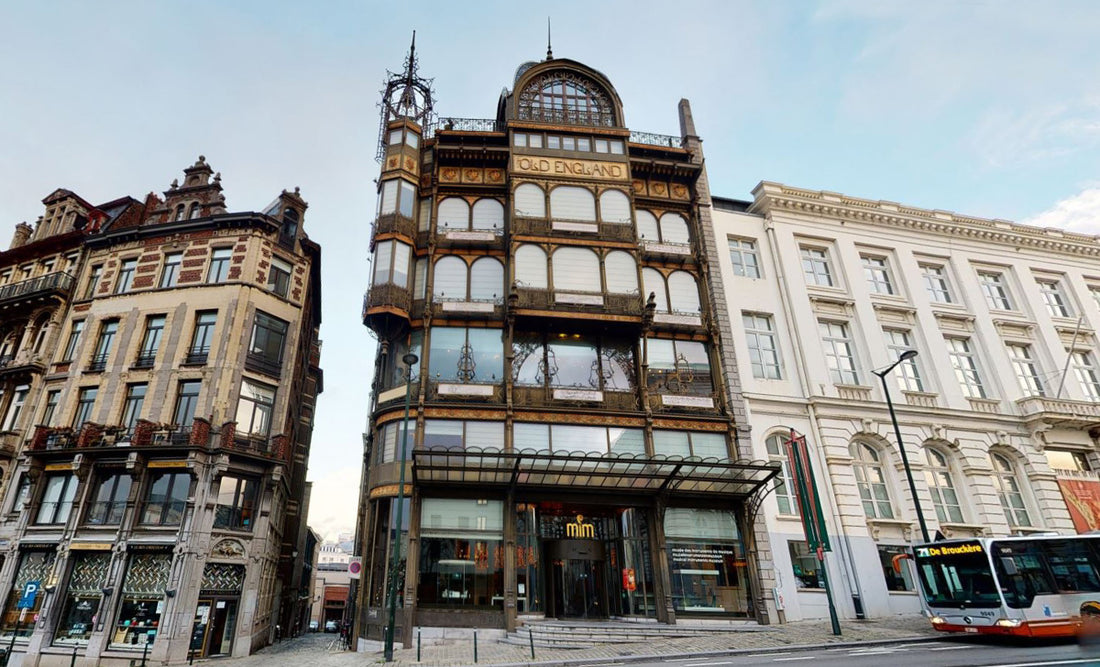Immersion in the Brussels Museum of Musical Instruments (MIM)

In the beginning…
Created in 1877, the Museum was initially attached to the Royal Conservatory of Brussels, in order to introduce students to old musical instruments. It brought together the collection of the famous Belgian musicologist François-Joseph Fétis (1784-1871), and the one offered in 1876 to King Leopold II by the Rajah Sourindro Mohun Tagore (1840-1914), which included about a hundred Indian instruments.
These collections were quickly enriched by the work of Victor-Charles Mahillon (1841-1924), the museum's first curator. He gave the institution its international scope. He purchased, among other, the impressive Contarini-Correr collection of 121 sixteenth- and seventeenth-century Italian and German instruments. When he died in 1924, the MIM already had 3,666 items, including 3,177 original musical instruments...
Impressive collections
Situated in Old England, an Art Nouveau architectural gem built in 1899, the Museum presents a wide variety of collections, spread over four floors of exhibitions. The first floor is devoted to traditions around the world. The second floor offers a chronological overview of instruments in Europe. The second floor is dedicated to keyboards, an essential invention in the history of instrument making. Level -1 houses the mechanical, electrical and electronic collections.

Armonica of glass, baroque musette with three chalumeaux, barrel organ, fujara, higheghe, janggu, hajhouj... The visit is a real tour of the musical world through an interactive experience and allows to listen to nearly 200 musical extracts.
Alongside the exhibition rooms, the Museum offers a space for practice, discovery and experimentation: the Workshop. When the time allows it, the Museum also organizes concerts, screenings, conferences, and workshops for children.
Adolphe Sax in the spotlight
The Sax family played an essential role in the making of wind instruments in the 19th century. Charles-Joseph Sax, established in Brussels, made and perfected many instruments before introducing his sons to the art of instrument making. The eldest, Antoine-Joseph, known as Adolphe Sax, is none other than the inventor of the saxophone (and many other instruments).

The MIM collections include a large collection of instruments made by members of the Sax family, the largest in the world in a public collection. Among the 125 pieces are saxophones, saxhorns, saxotrombas, cornets, trumpets, six- and seven-pipe instruments, omnitone horns, bugles, flutes, clarinets...

Since 2020, the MIM has been home to the oldest surviving saxophone in the world. It is a baritone saxophone dating from 1846, the year Adolphe Sax patented his invention. It bears the number 2686 and the inscription "Saxophone baryton en mi b breveté, Adolphe Sax à Paris".
In the area of the museum dedicated to wind instruments, visitors can watch a video tracing the genesis of the saxophone. It begins with the invention of the instrument by Adolphe Sax, and continues with the manufacture of a saxophone today in the workshops of Henri Selmer Paris. Our company is indeed closely linked to the inventor. When Henri Selmer bought Adolphe Sax's workshops in 1929, he integrated his staff and his know-how, thus conferring on his company the status of universal legatee of the saxophone invention.
Virtual visit
The MIM recently launched a virtual tour of its collections on its website. From your home, you can enter the museum and browse the different rooms full of historical instruments !

An initiative that allows you to continue to learn and feed your passion for music when access to culture is limited...
Photo/video credit: © Musée des Instruments de Musique de Bruxelles